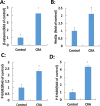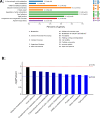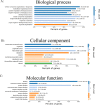Proteomics-based evaluation of the mechanism underlying vascular injury via DNA interstrand crosslinks, glutathione perturbation, mitogen-activated protein kinase, and Wnt and ErbB signaling pathways induced by crotonaldehyde
- PMID: 36002804
- PMCID: PMC9400244
- DOI: 10.1186/s12014-022-09369-7
Proteomics-based evaluation of the mechanism underlying vascular injury via DNA interstrand crosslinks, glutathione perturbation, mitogen-activated protein kinase, and Wnt and ErbB signaling pathways induced by crotonaldehyde
Abstract
Crotonaldehyde (CRA)-one of the major environmental pollutants from tobacco smoke and industrial pollution-is associated with vascular injury (VI). We used proteomics to systematically characterize the presently unclear molecular mechanism of VI and to identify new related targets or signaling pathways after exposure to CRA. Cell survival assays were used to assess DNA damage, whereas oxidative stress was determined using colorimetric assays and by quantitative fluorescence study; additionally, cyclooxygenase-2, mitogen-activated protein kinase pathways, Wnt3a, β-catenin, phospho-ErbB2, and phospho-ErbB4 were assessed using ELISA. Proteins were quantitated via tandem mass tag-based liquid chromatography-mass spectrometry and bioinformatics analyses, and 34 differentially expressed proteins were confirmed using parallel reaction monitoring, which were defined as new indicators related to the mechanism underlying DNA damage; glutathione perturbation; mitogen-activated protein kinase; and the Wnt and ErbB signaling pathways in VI based on Gene Ontology, Kyoto Encyclopedia of Genes and Genomes, and protein-protein interaction network analyses. Parallel reaction monitoring confirmed significant (p < 0.05) upregulation (> 1.5-fold change) of 23 proteins and downregulation (< 0.667-fold change) of 11. The mechanisms of DNA interstrand crosslinks; glutathione perturbation; mitogen-activated protein kinase; cyclooxygenase-2; and the Wnt and ErbB signaling pathways may contribute to VI through their roles in DNA damage, oxidative stress, inflammation, vascular dysfunction, endothelial dysfunction, vascular remodeling, coagulation cascade, and the newly determined signaling pathways. Moreover, the Wnt and ErbB signaling pathways were identified as new disease pathways involved in VI. Taken together, the elucidated underlying mechanisms may help broaden existing understanding of the molecular mechanisms of VI induced by CRA.
Keywords: Crotonaldehyde; Differentially expressed proteins; Indicators; Vascular injury; Wnt and ErbB signaling pathways.
© 2022. The Author(s).
Conflict of interest statement
The authors have no conflicts of interest to report.
Figures





Similar articles
-
Betacellulin and amphiregulin induce upregulation of cyclin D1 and DNA synthesis activity through differential signaling pathways in vascular smooth muscle cells.Circ Res. 2003 Aug 22;93(4):302-10. doi: 10.1161/01.RES.0000086803.64109.9E. Epub 2003 Jul 17. Circ Res. 2003. PMID: 12869389
-
Autophagy in Crotonaldehyde-Induced Endothelial Toxicity.Molecules. 2019 Mar 21;24(6):1137. doi: 10.3390/molecules24061137. Molecules. 2019. PMID: 30901980 Free PMC article.
-
iTRAQ-based proteomics reveals serum protein changes in hypertensive rats induced by a high-salt diet.EXCLI J. 2020 Nov 6;19:1496-1511. doi: 10.17179/excli2020-2740. eCollection 2020. EXCLI J. 2020. PMID: 33250683 Free PMC article.
-
Crosstalk Between Peroxisome Proliferator-Activated Receptor Gamma and the Canonical WNT/β-Catenin Pathway in Chronic Inflammation and Oxidative Stress During Carcinogenesis.Front Immunol. 2018 Apr 13;9:745. doi: 10.3389/fimmu.2018.00745. eCollection 2018. Front Immunol. 2018. PMID: 29706964 Free PMC article. Review.
-
Complexities of chromium carcinogenesis: role of cellular response, repair and recovery mechanisms.Mutat Res. 2003 Dec 10;533(1-2):3-36. doi: 10.1016/j.mrfmmm.2003.09.006. Mutat Res. 2003. PMID: 14643411 Review.
Cited by
-
The exposure to volatile organic chemicals associates positively with rheumatoid arthritis: a cross-sectional study from the NHANES program.Front Immunol. 2023 Jun 19;14:1098683. doi: 10.3389/fimmu.2023.1098683. eCollection 2023. Front Immunol. 2023. PMID: 37404817 Free PMC article.
-
Exposure to Toxic Compounds Using Alternative Smoking Products: Analysis of Empirical Data.Int J Environ Res Public Health. 2025 Jun 26;22(7):1010. doi: 10.3390/ijerph22071010. Int J Environ Res Public Health. 2025. PMID: 40724077 Free PMC article.
-
Regulation of endothelial function by cigarette smoke and next-generation tobacco and nicotine products.Pflugers Arch. 2023 Jul;475(7):835-844. doi: 10.1007/s00424-023-02824-w. Epub 2023 Jun 7. Pflugers Arch. 2023. PMID: 37285061 Free PMC article. Review.
References
-
- Goniewicz ML, Gawron M, Smith DM, Peng M, Jacob P, 3rd, Benowitz NL. Exposure to nicotine and selected toxicants in cigarette smokers who switched to electronic cigarettes: a longitudinal within-subjects observational study. Nicotine Tob Res. 2017;19(2):160–167. doi: 10.1093/ntr/ntw160. - DOI - PMC - PubMed
-
- Eder E, Schuler D, Budiawan . Cancer risk assessment for crotonaldehyde and 2-hexenal: an approach. Lyon: IARC Scientific Publications; 1999. pp. 219–232. - PubMed
Grants and funding
- LHGJ20220587/key scientific and technological research projects of henan province foundation
- LHGJ20190456/key scientific and technological research projects of henan province foundation
- QN-2019-B02/first affiliated hospital of xinxiang medical university youth science fund project
- GG2019037/technology breakthrough plan of science and technology department of xinxiang
- LHGJ20210521/key scientific and technological research projects of Henan Province Foundation
LinkOut - more resources
Full Text Sources
Research Materials
Miscellaneous
